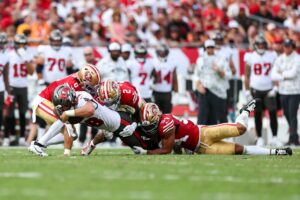It’s a fact, American Football is the most popular sport in the United States. The 2020 edition of the Super Bowl was watched by 100 million viewers in the United States alone. Even with a number of people still in doubt about how online sportsbooks work in Pennsylvania, a quarter of these viewers (26 million Americans) wagered $6.8 billion on the event. With such huge popularity, safety measures must always be at the forefront of our incredibly popular sport. However, last season saw a total of 224 players concussed. In this article, we will explain the best helmets to choose for maximum protection against chronic traumatic encephalopathy (CTE).

The 3 most famous helmet brands on the market are Schutt, Riddell and Xenith. These brands offer models with advanced technologies for protection and are widely used in the NFL. We will give you the best advice so that you can find the best helmet that suits you. Your head is the most important part of your body to protect. It is essential to follow the advice of your coach for good head support during the different phases of a match. Your future helmet should be made of polycarbonate or ABS plastic shell.
The hull is the first part of the impact. It is also the heaviest, most solid part of the helmet. It can have a standard rounder shape, or it can be wide. The standard shells have a lighter and more streamlined helmet. The large hulls are designed to distribute the impact better. They also allow you to have more padding inside which weighs down the helmet.
There are helmets proven to protect the brain. Riddell and Schutt have implemented technologies that allow you to absorb the impact through the shell. It is the Flex System for Riddell and the Tectonic 3DM System for Schutt. Inside the helmet is a padding that uses different technologies. Then, a grid is attached which will have a different shape depending on the position play on the field. Manufacturers design grids that are always more original and recognizable on the field.
Schutt uses TPU (thermoplastic polyurethane) with an Inflatable Liner on Certain Parts of the helmet
TPU has been used by Schutt Sports since 2003, because it absorbs more impact over a greater temperature range. Both hygienic and anti-bacterial, it is practically indestructible. It does not compress (compared to a foam) even after thousands of hits. Due to its shape, it also offers better air ventilation throughout the match. Different densities of TPU are used by Schutt to equip the interior of their helmets:
- Single Layer Dual Compression TPU, is built in a single layer which makes it lighter
- TPU VTD (Variable Thickness and Durometers) is specially designed to absorb impacts at low and high speeds
- TPU liner inside the helmet inflates with a suitable pump for a perfect fit. It is soft and has foam, which provides additional impact absorption. A “high impact” layer of foam is positioned at the forehead.
- Jaw protectors are placed on the sides (jaw pads). They come in different sizes (which you can easily change) for a perfect fit.
Schutt uses, on some of their models, the HSS system (Helmet Stabilization System) which stabilizes your jaw by framing your face. With the HSS system, new forms of very comfortable jaw pads are used.
Xenith and their Shock Absorber Technology
The Shock Absorbers Xenith uses, release air upon impact by providing optimal absorption. On the Epic model, the Shock Absorbers have 3 increasing levels of impact resistance: low, medium and high. In order to increase comfort and protection inside your head, comfort pads made of XRD foam (patented foam) are positioned on the Shock Absorbers. The Shock Absorbers are strategically placed around the head, which is independent of the shell. This reduces the rotational force of the head-on impact.
No pumps required, just tighten the chin straps for a perfect fit of the helmet onto your head. The “FitLock” system provides optimal tightening and adjustment of the helmet. Xenith is continuously proposing technological innovations based around player safety.
Riddell’s Helmet Technology
Riddell uses several patented technologies in a set of foam blocks which are positioned in strategic places for protection. All Riddell helmet models are equipped with PSIP (Patented Side Impact Protection) technology which reduces the force of lateral impacts (at the jaw). These helmets:
- Are equipped with a “Custom Fit Liner”, an inflatable liner for a personalized fit of your helmet
- Use inflatable jaw pads
- Have a Flexible Liner which provides comfort and stability of the helmet
- Use a flex system to reduce the force of impacts
- Have Ratchet-Loc Retention system that keep helmets more secure
Riddell has been manufacturing helmets for many years and have an excellent name. They were, for many years, official partners of the NFL and have been striving to reduce the NFL’s continuous concussion issue. Their designs and high-quality finish make them a high preference by players of all levels.
9 Tips on Fitting Your New Helmet
- Do not use your helmet until you have attached all the trim according to the manufacturer’s instructions. The sizes mentioned are only indications. There are different sizes of Jaw Pads that you can change to get the best fit.
- Adjust the air pressure if necessary to ensure a proper fit. The better your helmet is adjusted, the more it will be at its maximum impact absorption capacities.
- Check that the internal components of the helmet are placed correctly and intact. Change them if necessary.
- Check all rivets, screws, hooks, straps, eyelets and snap fasteners to make sure they are properly hooked and have the protective parts.
- To choose your helmet size, you must measure your head circumference with a meter of seamstress passing 2.5c above the eyebrows, around the widest part of the head. Then refer to the brand table which will tell you your size.
- Press 1 to 3 times on the pump. The helmet should be adjusted on your head but not too tight. Excess air may be released by turning the valve.
- You can now tighten your chin strap. The straps must pass under the grid. The wearer of the helmet holds the chin strap while adjusting and a second person regulates the tightness.
- The jaw pads must be glued to your face without pushing your cheeks too hard. If there is too much space between your cheeks and the jaw pads or if there is too much pressure, adjust the jaw pads to be comfortable.
- Your helmet should fit properly. It should follow the movements of your head.






